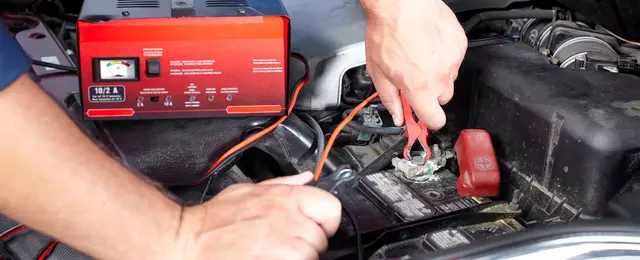
Car won’t start? Chances are you have a dead battery—again! Battery issues are commonly named as one of the top reasons a car is having trouble starting. Safety gear like battery chargers and jumper cables are important to have on hand in case of a dead or malfunctioning battery. Without a way to charge up a lifeless battery, you could find yourself stranded and in need of a tow.
Why Do I Need a Charge?
Every engine—whether it is a car engine, a boat engine, or a lawn mower engine—needs the power to start. In road vehicles, like cars and trucks, this power surge is provided by the battery. The battery must produce enough power to turn over the crankshaft, which then gets that engine going.car batteries are designed to recharge as the car runs. Sometimes, however, that battery flops down dead. Without a working battery, your car will never start.
There are many reasons why your battery may have died. More than likely, someone left the headlights on or a door or trunk open. The lights were on all night, and the battery is drained. It is also possible that the battery is not getting enough charge while the car is running. This could be due to poor connectivity or faulty parts. Another common reason your battery is draining is simply that it is old and needs to be replaced.
Older batteries do not hold the charge of younger, more enthusiastic batteries, and drain frequently.
Battery Charging or Jump Starting?
If you have a dead (or near-dead) battery, you will need some help to get your vehicle started. For this, you have two options—jump starting or battery charging.
To jump-start your car, you need a pair of jumper cables and another car. Hook your dead battery up to the running car using the cables. Your battery becomes charged by using the energy from the running battery. When you crank your engine, the running battery supports your battery to start the vehicle, and you can remove the jumper cables.
Car chargers are a second option for your dead battery. These are units that hook up to the battery and supply the energy themselves to charge it. This eliminates the need for a second vehicle to get you running again. These are very useful if the vehicle needing to be charged is parked in a way that it cannot be accessed by another vehicle—for example, if it is up against a building or surrounded by other cars. This can also be a good option if you find yourself stranded and alone. Unlike with a jump start, car chargers will charge your battery to a workable capacity before you start your car. Depending on the charger, this could take a few minutes to a few hours.
Charge It!
Car chargers for your dead battery come in two types. The first is corded. This type plugs into a wall outlet and uses that electricity to charge your battery. These are good for providing a steady stream of reliable power without worrying about the charger draining.
The other type is the portable battery chargers. These are good to keep in your fleet vehicles in case of emergencies. Portable car chargers do not need to be plugged in because they provide their own power source. This type of charger is designed to be kept in the vehicle at all times, ready to provide the charge you need regardless of where your car may be when it needs it. Portable car charges come in many different sizes and with different features. Though most importantly, some are more heavy-duty than others; if you are purchasing a portable car charger, be sure it can support the amperage needed to start your specific vehicle.
Professional Digital Marketer
Post new comment
Please Register or Login to post new comment.